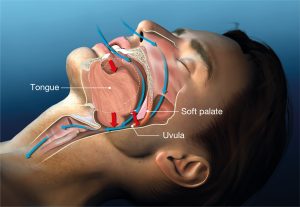What is Sleep Apnea
Sleep Apnea
Sleep Apnea is a serious, common, and treatable disorder that affects men, women and children. Obstructive Sleep Apnea (OSA) occurs due to tissue relaxation that blocks the airway while we sleep.
The cycle of apnea: |
|
| 1. | The apneic patient falls asleep |
| 2. | Muscle tone in the body relaxes |
| 3. | Airway narrows and/or collapses, causing breathing to be difficult or impossible. |
| 4. | The collapse of the airway may cause loud snoring, snorts, pauses in airflow, and labored breathing. |
| 5. | Oxygen levels begins to fall. |
| 6. | The apneic patient continues to struggle for breath…time goes by… 10, 20, 40 seconds… and longer… |
| 7. | Heart rate falls below normal—there is decreased oxygen to pump through the body. |
| 8. | Brain senses low oxygen/high carbon dioxide level, releases jolt of adrenaline—“fight or flight” response—to awaken brain and body and prevent suffocation. |
| 9. | Sleeper awakens briefly, takes five or six large breaths, breathing in oxygen and blowing off excess carbon dioxide (CO2). Sleeper typically does not remember arousal. Sleeper often repositions him or herself on the bed. |
| 10. | Heart rate speeds up in response to rush of adrenaline—now pumps above normal heart rate. |
| 11. | Oxygen/carbon dioxide levels return to near normal. Brain allows sleeper to resume sleeping. |
| 12. | Sleeper falls asleep. |
| 13. | Muscle tone relaxes… |
Cycle repeats.
Sleep Apnea: Phantom of the Night
It is not unusual for an apneic patient to have over one hundred arousals per night due to apnea, though he or she most likely will not remember any of them. This makes apnea suffers—especially those who live alone or sleep in bedrooms separate from their partners—vulnerable to not having their condition diagnosed for many years, if ever.
Severity of sleep apnea is measured by three variables.
| 1. | The number of apneic episodes per hour—also known as a respiratory disturbance index (RDI). |
| An RDI of 5-15/hr is considered mild sleep apnea. | |
| An RDI of 16-30/hr is considered moderate sleep apnea. | |
| An RDI of +30/hr is considered severe sleep apnea. | |
| 2. | Levels of oxygen desaturation. Normal waking oxygen saturation in a healthy child or adult is 96-99%. Normal asleep oxygen saturation in a healthy child or adult is 94-98%. |
| All oxygen desaturations <90% during sleep are considered medically significant. |
Snoring
Snoring can be thought of as very mild sleep apnea and occurs due to vibration of relaxed (floppy) tissues in the airway. Snoring is often associated with sleep apnea and is a good indicator that screening is necessary.
Common symptoms of sleep apnea include:
- Loud Snoring
- Choking or Gasping During Sleep
- Excessive Daytime Sleepiness
- Weight Gain
- Decreased Energy and Mood
Sleep Apnea is associated with long term health and safety concerns including:
- Heart Attack and Stroke
- Diabetes
- High Blood Pressure
- Weight Gain
- Mood Disorders: Anxiety and Depression
- Memory and Concentration Issues
- Car and Work Related Accidents
- Decreased Sex Drive
Sleep Apnea is easily treated, and once treated most health and safety risks come back to normal levels. Find out more about getting treatment…
The terms you might hear:
The apnea–hypopnea index (AHI) is an index of sleep apnea severity that combines apneas and hypopneas. The apneas (pauses in breathing) must last for at least 10 seconds and are associated with a decrease in blood oxygenation. Combining these gives an overall sleep apnea severity score that evaluates both number sleep disruptions and degree of oxygen desaturation (low blood level).
Apnea, apnoea, or apnœa (Greek: ἄπνοια, from ἀ-, privative, πνέειν, to breathe), is a term for suspension of external breathing. During apnea there is no movement of the muscles of respiration and the volume of the lungs initially remains unchanged.
In the context of diagnosis and treatment of sleep disorders, a hypopnea event is not considered to be clinically significant unless there is a 30% (or greater) reduction in flow lasting for 10 seconds or longer and an associated 4% (or greater) desaturation in the person’s O2 levels, or if it results in arousal or fragmentation of sleep.
The respiratory disturbance index (RDI) — or respiratory distress Index — is an formula used in reporting polysomnography (sleep study) findings. Like the apnea-hypopnea index (AHI), it reports on respiratory events during sleep, but unlike the AHI, it also includes respiratory-effort related arousals (RERAs). RERAs are arousals from sleep that do not technically meet the definitions of apneas or hypopneas, but do disrupt sleep. They are abrupt transitions from a deeper stage of sleep to a shallower.
A RERA is characterized by increasing respiratory effort for 10 seconds or more leading to an arousal from sleep, but one that does not fulfill the criteria for a hypopnea or apnea.






